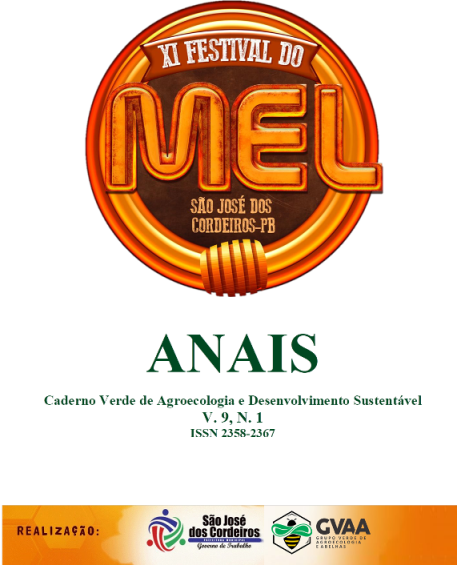EFFECTS OF POLLINATORS IN DIFFERENT ENVIRONMENTS IN CUCUMBER CROP
Keywords:
Cross pollination, cucumber, controlled environment, Melipona scutellaris.Abstract
Bees are spread throughout the Brazilian territory, being responsible for the proliferation and conservation of many plant species, reinforcing the importance in the production of these foods. The main goal of the experiment was to evaluate the efficiency of the pollination process, in open and controlled environments, on cucumber crop (Cucumis sativus L.) cultivar Marketmore 76. The design was completely randomized, with three treatments, two in closed greenhouses and one in an open greenhouse with free access to all pollinators and twenty repetitions per treatment, each plant was a repetition. In treatment 1 (T1), in a closed greenhouse without pollination, control treatment, in treatment 2 (T2), in a closed greenhouse, a colony of Melipona scutellaris, controlled pollination, was introduced during flowering, and in treatment 3 (T3), open greenhouse, with free pollination. The parameters evaluated were the frequency of bee visitation in flowers, average weight (PM) and average fruit diameter (CIRC), average weight (PMS), amount (NT) and dry matter content (MS%) of seeds. The frequency of bee visits to flowers was obtained by visual observation of male and female flowers, between 7:00 a.m and 17:00 p.m., for five consecutive days for 20 minutes every hour. According to the data obtained, the treatment 3 (T3), as it had no restrictions, was the one that registered the highest number of visitations, with peak hours in the intervals between 9:00 a.m. and 13:00 p.m., and it was verified the presence, in abundance, of Apis mellífera linguística. The pollinated fruits, equivalent to T2 and T3, presented significant differences for the parameters PM456g, CIRC21,3cm, PMS12,35mg, NT277, MS21%, higher 27,7%, 10,27%, 34,9%, 39,35. % and 23.81% respectively in relation to non-pollinated fruits of T1. T3 obtained total production (kg) of 24 and T1 and T2 10 and 5, respectively. With this experiment it was possible to prove the importance of bees as pollinating agents.Downloads
Published
How to Cite
Issue
Section
License
Termo de cessão de direitos autorias
Esta é uma revista de acesso livre, em que, utiliza o termo de cessão seguindo a lei nº 9.610/1998, que altera, atualiza e consolida a legislação sobre direitos autorais no Brasil.
O(s) autor(es) doravante designado(s) CEDENTE, por meio desta, publica a OBRA no Caderno Verde de Agroecologia e Desenvolvimento Sustentável, representada pelo Grupo Verde de Agroecologia e Abelhas (GVAA), estabelecida na Rua Vicente Alves da Silva, 101, Bairro Petrópolis, Cidade de Pombal, Paraíba, Brasil. Caixa Postal 54 CEP 58840-000 doravante designada CESSIONÁRIA, nas condições descritas a seguir:
O CEDENTE declara que é (são) autor(es) e titular(es) da propriedade dos direitos autorais da OBRA submetida.
O CEDENTE declara que a OBRA não infringe direitos autorais e/ou outros direitos de propriedade de terceiros, que a divulgação de imagens (caso as mesmas existam) foi autorizada e que assume integral responsabilidade moral e/ou patrimonial, pelo seu conteúdo, perante terceiros.
O CEDENTE mantêm os direitos autorais e concedem à revista o direito de divulgação da OBRA, com o trabalho simultaneamente licenciado sob a Licença Creative Commons do tipo atribuição CC-BY.
O CEDENTE têm autorização para distribuição não-exclusiva da versão do trabalho publicada nesta revista.
O CEDENTE têm permissão e são estimulados a publicar e distribuir seu trabalho online (ex.: em repositórios institucionais ou na sua página pessoal) a qualquer ponto antes ou durante o processo editorial, já que isso pode gerar alterações produtivas, bem como aumentar o impacto e a citação do trabalho publicado.








